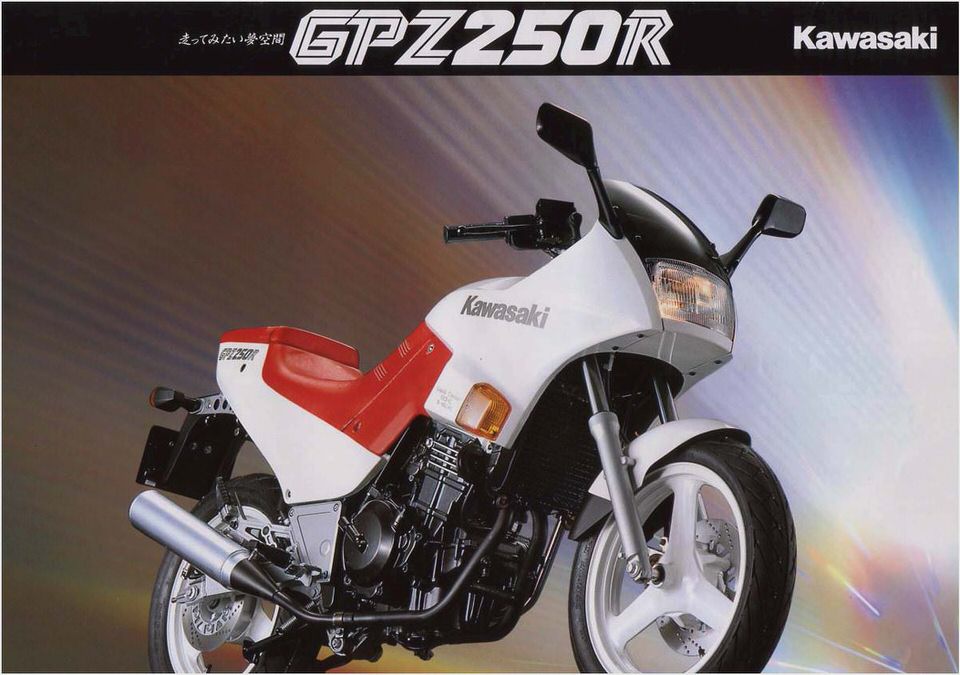
Description and features
In many respects, including ergonomics, chassis design, engine placement within the frame, the Ninja 250R straddles standard and sport classes. Likewise, the bike’s riding position falls between standard and sport. Capable of running the 1/4 mile in 14.6 seconds at 88mph, [ 1 ] the bike’s features include bungee hooks, center stand (no longer available on the 2008 model), a tachometer, and front and rear disc brakes. [ 2 ]
The bike has been heavily updated for 2008 [ 3 ] with completely redesigned fairings and 17 wheels. As of 2007, the 250R is being produced in Thailand. [ 3 ] Kawasaki has marketed the Ninja 250R since 1986 [ 3 ] as an entry-level [ 1 ] [ 2 ]
The Ninja 250 has little direct competition within its class in the United States, partly due to it being one of the two 250 cc sport bikes sold. In Canada, Honda’s 2007 introduction of the CBR125R has caused competition for Kawasaki’s share in the entry-level sport bike market. The other main competitors are the other 250 cc beginner bikes, namely the Hyosung GT250R, Honda’s Rebel 250 and Nighthawk 250, the Suzuki GZ250, and the Yamaha Virago 250.
With the exception of the Nighthawk, (standard) and the Hyosung, these bikes are all cruisers.
Before the 2008 model, neither the Ninja nor these other US 250’s had changed much in recent years, but outside the United States there were many advances in small-displacement, lightweight, and/or low-cost motorcycles, including several four-cylinder, sixteen-valve 250s (e.g. the Honda Hornet 250 or Ninja ZX-2R). That being said, the Ninja 250 enjoys a modest following among riders who appreciate its light weight and nimble handling as an amusing track bike. The very fact that it hasn’t changed much since 1988 means parts are plentiful and inexpensive, and the rider community is well established.
First generation
EX250-C – Also known as the GPZ-250. This earliest, belt-driven version was first produced in 1983, and has nothing in common with the latest generation.
Third generation
Fourth generation
In 2008, Kawasaki gave the EX250 its most thorough modernization in many years. The EX250-J model is known as the Ninja 250R worldwide. Kawasaki increased the MSRP by $500 U.S. to $3,499.
Parts from the third generation are still found on the -J, but its redesigned exterior panels bring the smallest Ninja’s appearance out of the ’90s and into line with late-2000s sportbikes. The engine and drivetrain retain 30% of the -F model’s parts, according to Kawasaki literature. The engine’s compression and maximum torque have been lowered to provide 20% better midrange performance, where the motorcycle will spend most of its time.
The U.S.-spec -J model uses dual carburetors like the -F model, but the European-spec and Thailand-spec model have a fuel-injection system. The wheels were increased in size to 17, the front suspension was beefed up, and the front brake rotors were replaced with a larger petal design. A fuel gauge, a rarity in motorcycles, was added to the instrument cluster, implying an emphasis on attracting new riders.
Motorsports
Since the introduction of the model in 1986, the Ninja 250 has been often used as a starting class bike in club racing around the world. The AFM in California has been especially involved with 250 Production racing since the bike was released, including the since faded Honda VTR250.
In 2007 (the last year of the 2nd generation EX250), the Ninja 250 of Hambone Racing, won the Overall Mini Endurance Championship with the Central Motorcycle Roadracing Association (CMRA). Piloted by CMRA longtimers Chuck Ergle and Keith Hertell, this marked the only time a Ninja 250 had ever won a CMRA Mini Endurance Championship.
Starting in 2008, the WSMC will have a class (The Ninja Cup) dedicated to the model.
- Old Bike Australasia: Ariel Square Four – The Squariel – Shannons Club
- Buy Kawasaki W800 Here!
- BUYING A KAWASAKI NINJA 600R – REVIEW AND VIDEO TEST eBay
- Nice but dangerous: Kawasaki?s new 1700 Voyager- an owners 1500 mile r…
- Kawasaki klr 650 TransWorld Tour

